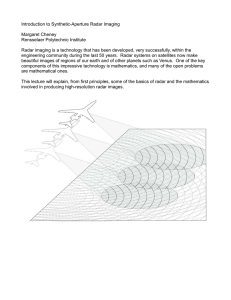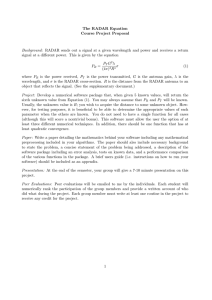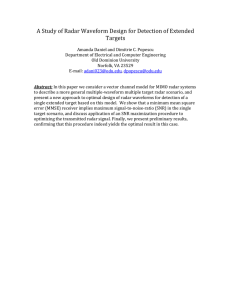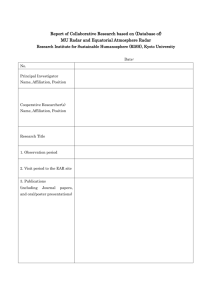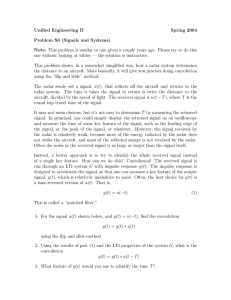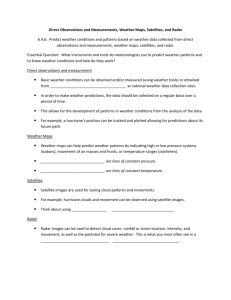Interference Risk to Radar Altimeters from Planned 5G Telecommunication Systems
advertisement
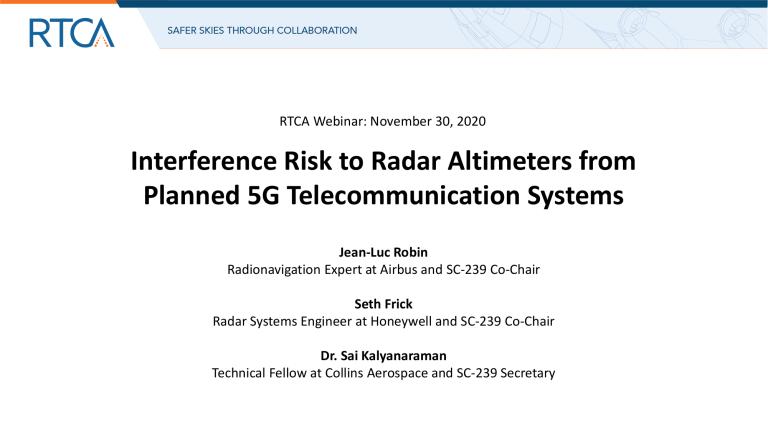
RTCA Webinar: November 30, 2020 Interference Risk to Radar Altimeters from Planned 5G Telecommunication Systems Jean-Luc Robin Radionavigation Expert at Airbus and SC-239 Co-Chair Seth Frick Radar Systems Engineer at Honeywell and SC-239 Co-Chair Dr. Sai Kalyanaraman Technical Fellow at Collins Aerospace and SC-239 Secretary Introduction to Radar Altimeters Radar Altimeter Background and History • • • Radar altimeters transmit a radio frequency (RF) signal from the aircraft down to the terrain and receive the reflected signal back The time delay of the received signal is used to determine Above Ground Level (AGL) altitude Radar altimeters are the only sensor onboard an aircraft which can make a direct measurement of AGL altitude • • Widespread use in civil aviation began in the 1970s following several deadly Controlled Flight into Terrain (CFIT) accidents • • All other altitude sources, e.g. barometric, GNSS, etc. are referenced to an absolute datum (sea level or ellipsoid), and not relative to the terrain Example: TWA Flight 514 crashed outside of Washington, D.C. in Dec. 1974 Used today on all types of civil aircraft—commercial transport airplanes, business and general aviation airplanes, and helicopters Beam Width Radar Altimeter Technology • • Operate in the global Aeronautical Radionavigation Service (ARNS) from 4.2–4.4 GHz Radar altimeters are either pulsed or frequency-modulated continuous wave (FMCW) • • FMCW is far more common for radar altimeters used in civil aviation In FMCW altimeters, RF front-end typically uses homodyne architecture, with the received signal mixed with the transmitted signal to measure the frequency difference • With linear FM chirps, this frequency difference is directly proportional to the propagation time delay, and thus altitude Transmitted (TX) and Received (RX) FMCW signals Simplified FMCW front-end. Some commonly used components such as RF BPF and LNA (both ahead of the mixer) are not shown. Radar Altimeter Usage in Civil Aviation • On commercial transport airplanes and high-end business and GA aircraft, radar altimeters provide critical inputs to a wide range of aircraft systems and functions: Radar Altimeter Requirements and Certification • • In civil aviation, certified aircraft generally utilize radar altimeters which have been approved by the FAA through the Technical Standard Order (TSO) process Obtaining TSO authorization involves validation and testing of the radar altimeter design against a standardized set of performance requirements • • Initial radar altimeter requirements were given in TSO-C87 (released in 1966) • • Similar requirements were later incorporated in the RTCA DO-155 MOPS (released in 1974) TSO-C87 superseded by TSO-C87a in 2012 • • Requirements are either defined in the TSO itself, or by reference to a Minimum Performance Specification (MPS) or Minimum Operational Performance Standards (MOPS) TSO-C87a references performance requirements in the EUROCAE ED-30 MPS (released in 1980) In all cases (TSO-C87, DO-155, and ED-30), there have been no specific requirements regarding interference susceptibility or receiver masks • Latest update to requirements was 1980—what did the RF spectrum look like then? Current Interference Environment for Radar Altimeters RF Spectrum Surrounding Radar Altimeters • Majority of current usage near the radar altimeter band is Fixed Service (FS) and Fixed-Satellite Service (FSS) links • • • FS links may have relatively high EIRP, but are sparsely distributed and utilize highly directional antennas FSS is Space-to-Earth (downlink) only, resulting in very low interference power Mobile allocation above 4.4 GHz is used in the U.S. for Aeronautical Mobile Telemetry (AMT) • Currently limited to Federal use—generally isolated to specific test ranges From ITU Radio Regulations, Edition of 2020, Vol I. Current High-Power Potential Interference Sources • The immediate spectrum neighborhood around the radar altimeter band is relatively quiet • High-power emissions sources (such as ground-based surveillance radars) are generally far from the band, e.g. below 3.5 GHz • Airworthiness standards from the FAA and other aviation authorities include requirements to tolerate High-Intensity Radiated Fields (HIRF) • • • Includes continuous wave (CW) and pulsed high-power interference signals However, an exclusion band is allowed ±10% around the band, within which the HIRF levels are very low—for radar altimeters, this spans 3.78–4.84 GHz Therefore, HIRF requirements are not sufficient to protect against interference from modern communications waveforms close to the radar altimeter band Evolution of the Interference Environment The Push for “Mid-Band” Spectrum • • • The radar altimeter band lies in the middle of a spectrum sweet spot, allowing for large bandwidths with favorable terrestrial propagation properties Spectrum regulators worldwide are working to make more of this “mid-band” spectrum available for 5G mobile wireless applications In the United States, the FCC has made mid-band spectrum a key priority in its Facilitate America’s Superiority in 5G Technology (5G FAST) Plan1 • • Mid-band spectrum is extremely valuable—70 MHz in the 3.45–3.55 GHz band was recently auctioned for $4.6B in the United States2 • 1. 2. 3. Includes new allocations of 3.45–3.55 GHz and 3.7–3.98 GHz 3.7–3.98 GHz band expected to be even more valuable—total auction proceeds likely to be in the tens of billions3 https://www.fcc.gov/5G https://docs.fcc.gov/public/attachments/DOC-366624A1.pdf https://www.cnet.com/news/verizon-and-dish-score-big-in-midband-5g-wireless-auction/ Anticipated Changes to RF Spectrum New mobile allocations (primarily for 5G) being actively developed or considered: SC-239 Study: 3.7–3.98 GHz in the United States 3.7–3.98 GHz: Background • • • In 2018, FCC announced their intent to establish a new spectrum allocation for 5G in the 3.7–4.2 GHz band Aviation industry representatives, led by the Aerospace Vehicle Systems Institute (AVSI) at Texas A&M University, conducted testing and analysis to evaluate the risk of harmful interference to radar altimeters and submitted results to the FCC In March 2020, the FCC released a Report and Order finalizing the spectrum allocation from 3.7–3.98 GHz, to be auctioned in December 2020 • • • FCC acknowledged further study was needed regarding coexistence issues with radar altimeters, but no operating limitations for the band were defined specifically to prevent interference In April 2020, RTCA established a 5G Task Force within the newly-formed Special Committee 239 to further investigate the issue and generate a technical report In October 2020, SC-239 report released publicly and provided to the FCC 3.7–3.98 GHz: Issue Summary • • 5G usage in the 3.7–3.98 GHz band will lead to widely-deployed, high-power emissions sources in this band Two means of potential interference to radar altimeters: • • • 5G fundamental emissions overcoming the filtering in the altimeter receivers (blocking) 5G spurious emissions landing within the 4.2– 4.4 GHz band directly Radar altimeters are inherently wideband systems, and currently have no requirements for front-end rejection—may be more susceptible to blocking than other types of receivers SC-239 Study Methodology Overall guiding principle (based on ICAO guidance): worst-case analysis of currently fielded TSO-approved radar altimeters SC-239 Study Results Usage Category 1: Commercial airplanes used for passenger travel and cargo transport Red dots mean that the safe interference limit is exceeded BUT EXTREME IMPACT ON AIRCRAFT Although the interference impacts for Usage Category 1 only arise in certain scenarios, the extent and safety consequences of those impacts are extreme: • Unreliable radar altimeter signals delivered to the critical aircraft systems: Auto Pilot, Flight Controls, Terrain Avoidance, Cockpit Displays. • Catastrophic impact with the ground, leading to multiple fatalities, is possible. Aircraft Height LIMITED NUMBER OF 5G SCENARIOS INVOLVED The impact to radar altimeters is limited to a set of specific scenarios, with only some base station configurations producing interference above the safe limit, and only for certain combinations of aircraft altitude and lateral distance between the aircraft and base station. Distance from 5G Base Station SC-239 Study Results Usage Category 2: Business aviation, general aviation, Safe interference and regional transport airplanes limit Usage Category 3: Both transport and general aviation helicopters Expected 5G interference levels HUGE AMOUNT OF SCENARIOS INVOLVED Every base station configuration produces harmful interference both from 5G fundamental emissions in the 3.7–3.98 GHz band and 5G spurious emissions* in the 4.2–4.4 GHz band, across virtually all operational scenarios and relative geometries between the aircraft and base station. 5G user equipment (mobile phones) that may be operating onboard aircraft were also found to exceed the safe interference limits for Usage Categories 2 and 3. *Note: 5G spurious emissions level is not compliant with Recommendation ITU-R M.2059 protection criteria Continued Efforts Moving Forward • RTCA SC-239 is working jointly with EUROCAE Working Group 119 to develop new radar altimeter MOPS, which will include interference tolerance requirements • However, the new MOPS will only result in improved radar altimeter designs in the future—currently fielded radar altimeters will still be exposed to 5G • What will the FCC do? • Aviation industry is proposing mitigation actions to help protect radar altimeters, but the outcome is uncertain • What will the FAA do? • The safety of the National Airspace System must be maintained, but it is unclear what specific actions the FAA may take if 5G is deployed without mitigations

